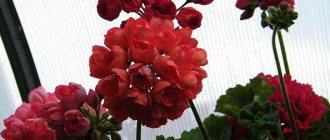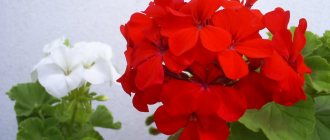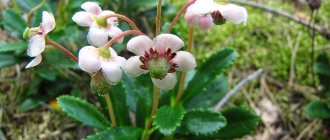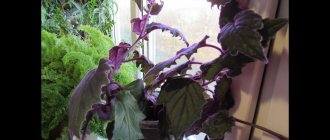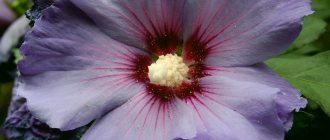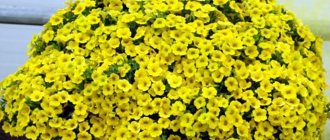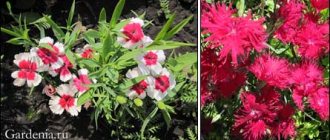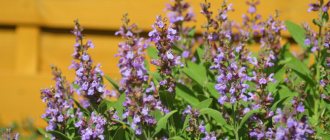Description of the plant
Geranium looks like a flower with erect, strong stems, covered with alternating terry leaves, which, when touched, release the aroma characteristic of the plant.
Geranium fragrant
The flowers are small, symmetrical, consist of 5 or 8 petals, are not collected in lush inflorescences, and are scattered singly throughout the plant. One plant usually produces 10 pedicels.
For reference! The petals of wild geraniums can be blue or purple, while selectively bred ones are raspberry, pinkish or white.
Geranium and pelargonium difference
Varieties of the flower Codium Croton, its varieties
At the end of the 18th century, the scientist Carl Linnaeus, when compiling a classification of plants, combined two representatives of the Geranium family, geraniums and pelargonium (pelargonium graveolens), into one species, named after the first.
One of the differences between geranium and pelargonium is the color of the petals.
Despite the general similarity, the plants differ in appearance. The main difference is the shade of the inflorescences - pelargonium blooms white or all shades of red, for example, the grandeur variety, but in no case blue, a similar shade is characteristic only of geranium.
Another important difference is the homeland and the necessary growing conditions.
- Geranium grows in wild conditions of temperate climates, and therefore tolerates wintering well in open ground.
- Pelargonium is a heat-loving plant from South Africa, so it can only grow in indoor or greenhouse conditions; it is useless to care for it in open ground, since it will immediately die at the first frost.
Attention! Many lovers of indoor flowers do not distinguish between these varieties and often call pelargonium geranium and vice versa.
As a result, confusion often arises when in catalogs a plant is called, for example, lemon geranium, but ordinary people believe that it is lemon pelargonium and are looking for it by this name.
Features and differences from other types
Fragrant pelargonium fully lives up to its name, because the smell is its calling card. But the plant does not differ in beautiful flowers. The Pelargonium triste flower was first found in South Africa, from where it was brought to Europe, where the plant became the basis for obtaining a whole group of fragrant geraniums. Over three hundred years, many varieties of pelargonium have been developed, which differ in the shape of the leaf blade. The leaves and stems exude the aroma of apple, cinnamon, rose, nutmeg, lemon - in total more than 150 scents are distinguished!
Phytoncides cleanse the room of harmful microbes, and moths do not appear in the room where the pelargonium is located. For this reason, this green space received another name - “molly tree”. This type of geranium has decorative foliage, but the flowers are small. True, there are varieties strewn with flowers, and then it seems that pelargonium is covered with butterflies. The essential oil that geranium produces has healing properties and is used in perfumery.
Geranium and fragrant pelargonium: varieties and varieties
Tulip geranium - popular varieties for the home
Many years of experience and the work of breeders allow today's gardeners to grow geraniums and pelargoniums with flowers of various shades. In addition, each variety has its own aroma, for example, geranium can be found with the scent of lemon, rose, orange, chocolate, nutmeg, etc.
- Lemon geranium. The unpretentious flower averages 0.7 m in height, but can reach up to 1.5 m in height, making it popular in garden beds. The leaves of the plant have a characteristic shape in the form of bright green, rich snowflakes, the touch of the wind or hands spreading a spicy aroma with notes of lemongrass throughout the garden.
- Pelargonium Candy dancer is distinguished by its compact size and fluffy shape, which is acquired and maintained through frequent pinching. This variety is characterized by carved, dark green and terry foliage, spreading the aroma of mint and lemon balm, in some cases the aroma is reminiscent of the most fragrant oriental sweet - Turkish delight. The flower does not tolerate direct sunlight, preferring partial shade. The petals have a delicate pinkish tint, with bright crimson splashes.
What does lemon pelargonium look like?
- Geranium with carved leaves “Chocolate” differs from all varieties by its color-changing foliage, a mixture of chocolate and mint closer to the edge. Light flowers gather in a cap over the greenery.
- Ardwick Cinnamon geranium appears in the form of miniature bushes with foliage resembling the top appearance of green trees with a rich cinnamon aroma. The long period of flowering with small, white, silver-tinged inflorescences makes this variety popular for decorating flower beds.
- The pelargonium variety Charity is characterized by delicate light green foliage with a white edge, spreading the scents of rose and orange, for which it received the second name orange. The flowers are collected from five elongated petals of a pinkish hue with more saturated inclusions.
- The scent of Gemstone geranium is reminiscent of citrus fruits. Low bushes up to 0.5 m high with light green heart-shaped leaves with a white border bloom with delicate pink buds, splendor and many layers, reminiscent of miniature peonies. This variety looks harmonious in combination with compact garden geranium mabel gray.
Interesting! The scents of geraniums of the odorata, perfume or rise varieties are often found in the perfumes of famous brands.
Fragrant geranium medicinal properties and contraindications
The beneficial properties of this plant have been known for a long time, and many traditional healers successfully use them in the treatment of such ailments as:
- gastritis and gastric ulcers;
- fever;
- insomnia;
- colds;
- radiculitis;
- haemorrhoids;
- gout;
- adrenal diseases;
- inflammation of various types;
- arterial hypertension, etc.
To make potions, fresh leaves of fragrant geranium are cut. Usually they are not dried, but simply washed under running water. Later, medicinal decoctions, water and alcohol tinctures and extracts are made from these leaves. But to get rid of some symptoms and conditions, sometimes you don’t even need to prepare any mixtures.
For example, to get rid of a headache, you just need to pick a couple of leaves, fold them in four, roll them into a tube, and insert the sharp edge into the ear hole. After some time, according to expert healers, the pain will begin to subside.
And to normalize high blood pressure, it is enough to bandage 1 pelargonium leaf to the back of each wrist.
You don’t have to bother with preparing a drug to relieve symptoms of otitis media. To prepare effective drops, you need to cut off several leaves, chop them finely, collect them in a pile, and squeeze them through gauze into a prepared container. The juice of the leaves is collected with a pipette and dropped into the ears. It's simple.
Fragrant geranium: home care
If we talk about fragrant, fragrant or lemon geranium, then care involves following a few simple rules. They will be discussed below.
Geranium Rozanne
The optimal place for growing gourmet geranium varieties, as they are also called, is the window sill in the southern part of the house. The plant should not be provided with shelter and partial shade, since most varieties of geranium bloom poorly or do not bloom at all in insufficient light.
The air temperature in the room in the warm season should vary between +20-+30°C, so in the summer months it is recommended to take geraniums to an open loggia or veranda. In winter, the plant feels great when left on the windowsill at a temperature of +8-+12°C. Overwintering at higher temperatures can harm geraniums.
Advice! The symmetrical shape of the gourmet bush is ensured by uniform exposure to sunlight, which can be ensured by regular rotation of the geranium.
Watering rules
Geranium fragrant prefers moderate soil moisture and tolerates aridity fairly well. But excess moisture in the soil leads to the fact that the roots of the crop begin to rot, and the upper part of the bush wither and wither.
One of the main procedures for caring for pelargonium is watering.
In the warm season, it is recommended to water fragrant geraniums abundantly 2-3 times a week after the top layer of soil has dried to a depth of 1.5-2 cm. It is recommended to drain excess water that has seeped through the drainage holes into the pan half an hour after watering.
In winter, the plant slows down metabolic processes inside, consuming less water, so the frequency of watering is reduced to once every 7-10 days.
Interesting! Some types of geranium are used as a seasoning or folk treatment, before using which it is strongly recommended that you familiarize yourself with the contraindications!
Planting container
The size of the pot directly affects the growth and abundance of flowering of lemon pelargonium or geranium. In small pots, geranium blooms brightly and for a long time. Small containers are ideal for young seedlings.
Large-diameter pots stimulate intensive root growth and abundant green mass. For comfortable growth and development, the plant needs a container of 12-14 cm in diameter and approximately the same height. A wide pot or container is recommended for multiple plants.
Note! Over time, fragrant geranium fills the entire area of the pot with its roots, so when planting a young crop, it is not recommended to choose a large-diameter container, as this will complicate the replanting process in the future.
Transfer
Fragrant pelargonium is replanted once a year, but it can be done more often if there are signs that the flower is crowded, for example, an abundant density of green mass. The container for transplantation should be 2-4 cm in diameter larger than the previous one.
Important! Flower growers do not recommend planting crops in square-shaped containers, since moisture often accumulates in the corners, which leads to decreased ventilation and the development of mold on the roots.
You can replant fragrant geranium at any time, regardless of the season, as the unpretentious flower quickly takes root. Many gardeners recommend replanting the plant in the spring months, when it accelerates internal metabolic processes and recovers in a short time. During the budding period, the transplanted plant will be forced to direct all its efforts to adapt the roots to the new environment, which affects the duration and abundance of flowering.
Transplanting geraniums into a new container with a slightly larger diameter
You can understand that a flower should be replanted by the following signs:
- geranium has stopped growing and increasing its green mass;
- increasing the frequency of watering due to rapid drying of the soil, since the roots occupy all the free space in the pot and require more moisture;
- the overgrown root system is visible at the bottom of the pot through the drainage holes;
- When the plant is removed from the pot along with the earthen ball, the roots are completely enveloped in the soil.
Before planting, the new pot is disinfected using a disinfectant solution. Water is first poured into the clay pot for a couple of hours, drawing out toxic substances and fumes released when firing the clay. After which the ceramic pot is thoroughly dried and filled with soil mixture.
A 3-4 cm drainage layer of expanded clay or small pebbles must be laid at the bottom of the planting container, onto which a small layer of soil is poured and the geranium is installed along with a lump of earth. The voids on the sides of the pot are tightly filled with moistened soil.
Advice! Before planting, it is recommended to inspect geranium graveolens for diseased or damaged roots, which are cut off with a sharp, disinfected knife and sprinkled with activated charcoal or charcoal powder.
Main varieties
Today there are a huge number of different varieties of plants, but not all of them are considered popular among gardeners.
Most often on the windowsill you can find the following varieties of aromatic pelargonium:
- Lemon - distinguished by rough leaves with slight pubescence, flowers are small, lilac-pink. Under optimal conditions, the plant can grow up to 1–2 m in height, so it is often used as a standard species. The plant has a distinct lemon aroma, which is released after touching the leafy hairs.
- Felt is a low-growing, compact bush, highly branched. The leaves are covered with numerous small hairs, which creates the effect of felt fabric. The flowers on the bush are small, pale white, with purple splashes. A distinctive feature of the plant is the delicate minty smell that is released by the green mass.
- Grape -leaved is an erect bush, about 90 cm high. The variety is named due to the special shape of its leaves, reminiscent of grape foliage. During flowering, white-pink or pink-purple flowers with bright stripes are formed on the bush. The plant has a delicate scent, including notes of lemon and rose.
- Apple cider is a small flower and is characterized by small, rounded leaves with wavy edges and small white flowers. The green mass has a delicate apple aroma, while the leaves emit a lemon-pink aroma. The flower develops well both indoors and in the flowerbed.
- Lady Plymouth is a small compact bush that is ideal for growing in pots and containers. The leaf blade is heavily dissected and has a white border along the edge. The flowers are medium size, soft pink. They have a delicate but distinct rose scent.
- Gray Lady - the flower is characterized by large dissected gray flowers with a thin white border. The flowering of the bush is inconspicuous; small white flowers develop on the shoots, gathering in small inflorescences.
- Curly is an erect or climbing shrub, up to 70 cm high. The stem is most often herbaceous, but becomes woody over time. The leaf blade is cut, strongly twisted. Flowers develop white, lilac or pink. This geranium has a strong lemon aroma, so it is often used in cooking.
- Paniculata is a small ornamental shrub distinguished by small white flowers and small curly leaves. The foliage has a rather exotic smell, combining the aromas of mint, rose and nutmeg.
Trimming
Pruning or pinching young shoots allows you to form a geranium crown; the absence of such a procedure will lead to active stretching of the stem with a small amount of foliage. Faded inflorescences, damaged or dry shoots must be cut off. If desired, you can trim long shoots.
You can prune geraniums until December, after which the flower is left alone until March. In spring, it is recommended to cut off weakened and long shoots, allowing the geranium to produce new leaves and lay many buds for lush flowering. Each cut shoot must have at least 3 buds, which guarantee lush flowering.
Pruning and pinching geraniums
Pruning is almost the most important thing in caring for geraniums in a pot at home. If this is not carried out, the plant will stretch upward, tilt, produce few inflorescences and leaves, and flowering will become shorter. The formation of the crown must begin while the pelargonium is still small and its stems have not had time to stretch.
- The fact is that at each node of the main trunk there are dormant buds, which rarely produce lateral shoots on their own - for this they need to be stimulated by pruning elongated shoots.
Trimming geraniums is not difficult, especially since it only needs to be done 1-2 times a year. Cut flower stems can be thrown away, or they can be used for propagation (we'll talk about this below). Pruning is also needed to improve ventilation in the crown, prolong flowering and improve the health of the plant as a whole.
- Of course, the shape of geraniums may differ depending on the variety - some varieties of pelargonium are more stocky, and some are taller. There is no need to change such features by forming pruning.
This photo shows an example of elongated pelargonium, which is long overdue for pruning. In order for the beautiful geranium to grow as a neat and lush bush, to be healthy and to bloom longer, it definitely needs a “haircut” 1-2 times a year - in winter and/or spring
So how to prune geraniums? The first thing to do is to choose the optimal time when the plant is able to survive such stress without damage.
- Pruning geraniums in spring (from late February to March) is the main and most significant. Its goals: to form a crown, awaken dormant buds and stimulate the growth of side shoots.
- Pruning geraniums in the fall is to improve the health of the plant, relieve stress during the dormant period (it lasts from December to mid-February) and prepare for the next flowering season. Autumn pruning has almost no effect on crown formation. An important nuance - you can only prune a plant that has finished blooming.
Let's move on to practice.
How to prune geraniums in spring?
Step 1: Prepare your tool and charcoal. Disinfect a sharp garden knife with alcohol or heat it. Keep in mind that scissors cannot be used, as pressure is harmful to the plant. You will also need activated carbon powder to process the cuts.
Step 2. Determine the extent of pruning of the geranium and trim the main trunk. It depends on the plant variety:
- Miniature pelargoniums are not pruned every year and sparingly - only the elongated stems are only a couple of centimeters.
- Pelargoniums of medium height are shortened by a third. The cut is made just above the leaf node, which is directed outward from the crown of the plant at a right angle.
- Tall varieties of geranium are cut to 2/3 of the height and thinned out quite strongly - leaving only 4-5 of the strongest shoots.
Step 3. Remove all stems directed inward of the crown. This can be done by hand, simply breaking off unnecessary stems, or using scissors.
Step 4. Remove all faded inflorescences and yellowed leaves. At the end of the procedure, the central part of the crown should remain open so that air can circulate freely around it.
Step 5. Cut the stems to your taste. We form a crown, if necessary.
Step 6. Sprinkle the cut areas with coal. Coal can be replaced with ground cinnamon.
Step 7. Feeding with nitrogen fertilizer. This is not necessary, but it can speed up the growth of geraniums after pruning (only in spring). The main thing is not to overdo it, otherwise the plant will grow into only leaves.
Important nuances
- You need to trim geraniums with disinfected scissors (alcohol or boiling water).
- Geraniums do NOT need to be watered 2 days before and 2 days after pruning.
- In summer, you can “clean” the geranium crown a little by breaking off/cutting off dried leaves or stems.
Now let's talk about autumn pruning of geraniums. It is not always needed and not for all varieties of geranium.
- Royal geraniums are pruned in both autumn and spring. Moreover, autumn pruning can be quite radical - to the stump. Fortunately, royal geranium grows new shoots and flower stalks very quickly.
- Ampelous and zonal varieties of geranium can be pruned only in the spring if the plant does not need much correction of its shape.
- Miniature pelargoniums do not need to be pruned every year and sparingly - you only need to shorten the elongated stems by a maximum of 1-2 centimeters.
- It is generally undesirable to prune variegated varieties.
Step 1. When flowering is over, remove faded flower stalks, as well as wilted and withered leaves.
Step 2. Next, cut off all elongated, weakened and leafless stems by about a third. Do not regret that after pruning the plant will become inconspicuous, because in the spring its crown will become even more beautiful and voluminous.
In addition to pruning approximately 2-3 times during the entire growing season (from late February to September), geraniums need pinching. What does it mean?
- Pinching is the removal of the growth point in young shoots when they grow excessively (when more than 5-6 leaves are formed on the stem). Thanks to pinching, the formation of side shoots is also stimulated, and the splendor of the plant is achieved.
Soon after pinching, new shoots form in the leaf axils, which bloom in about 2-2.5 months.
Below in the gif image you can see how to pinch geraniums by hand (you can do this with scissors).
See also:
- How to care for Kalanchoe at home
- Anthurium - home care guide
- Caring for indoor hydrangea at home
- How to care for myrtle at home
- How to care for dracaena at home
- How to care for Schefflera at home
- Tree in the room: how to care for Ficus Benjamin at home
- How to care for begonia at home
- Caring for Zamioculcas (dollar tree) at home
- How to care for aloe at home
- How to care for money tree (crassula) at home
- How to care for hibiscus (indoor Chinese rose) at home
- How to care for orchids - 7 steps for a beginner
- How to care for violets at home
Features of flowering
Most varieties of fragrant geranium bloom between May and October for about 40 days. Some varieties have a year-round flowering cycle.
Geranium produces single, paired or collected in inflorescences in the form of zonal buds, the petals of which can be of a wide variety of shades. The variety affects not only the color and duration of flowering, but also the shape of the inflorescence and the number of petals on it.
On average, one inflorescence consists of 5 or 8 delicate velvety petals, in the center of which a fruit-box in the shape of a stork’s beak then ripens.
Note! There are non-flowering evergreen varieties, for example, pelargonium bontrosat.
Non-flowering variety of fragrant pelargonium Bontrosai
What is the difference from fragrant pelargonium
Considering the colossal variety of varieties and their similarities, a non-specialist can distinguish geranium from pelargonium only by indirect signs, because there are still characteristic differences.
Types of geranium - what happens, popular varieties
Pelargoniums do not come with flowers in purple and blue shades. Geraniums have flowers with only 5 petals; in addition, there are varieties without flowers at all (non-flowering).
Geranium does not form an ampel; its shoots tend to always stretch upward. Pelargonium is ivy-leaved without a pubescence on the leaves, with double flowers and drooping long branching shoots.
Attention! It is impossible to cross pelargonium and geranium at home.
Reproduction
Representatives of the Geranium family reproduce in three ways: seeds, cuttings or roots.
Shoots cut during crown formation can be used as cuttings. It is also possible to purposefully cut the cuttings at any other time.
On a note! The strongest cuttings are those taken in the fall after flowering has completed.
Having planted an autumn cutting, you can expect flowering only in the summer. A cutting cut and planted in the spring will bloom in the coming summer, but cutting will lead to inhibition of flowering on the mother bush.
Healthy shoots 7-10 cm long are cut as cuttings, the cut site is treated with a preparation to stimulate root formation, and the lower leaves are removed. After which the planting material is planted in a hole prepared in advance. You can also root the cuttings in a container of water with the addition of 1-2 tablets of activated carbon; after the roots appear, the seedlings are planted in the soil.
One of the ways to propagate fragrant pelargonium is by cuttings
Propagation by roots is carried out if a young sprout appears on the root in the above-ground part away from the mother plant. In this case, the mother root is divided so that each new sprout has part of the root system.
Geranium seeds are collected from a ripened fruit or purchased in a store. A soil mixture of turf soil, peat and coarse sand is pre-mixed in proportions 2:1:1. Geranium seeds are placed in a disinfected planting container and soil mixture, lightly sprinkled with water and sprinkled with a thin layer of sand. The container is covered with a glass lid or cling film with several holes for ventilation and put away in a warm place. As soon as the first shoots hatch, the film is removed and the container is moved to a warm and bright place.
Advice! To speed up the germination of sprouts, before planting, it is recommended to rub the seeds with fine sandpaper and dip them in a growth stimulator solution.
The natural cycle of seeds until they hatch without such stimulation can last up to 3 months.
After 2 weeks, when the first shoots appear, it is recommended to pick them, and after the 6th leaf appears, pinch them.
Transplantation and propagation
Geranium does not respond well to such procedures and avoids them for a long time. Therefore, geranium transplantation should be done only in the following cases:
- due to transplantation from flower beds into pots for wintering (with the onset of autumn);
- if the plant grew from a small pot;
- if the plant was accidentally turned over due to negligence and fell out of the pot;
- if there is mold damage to the soil in the pot (which is immediately noticeable by the specific smell after watering);
- if geraniums are going to be propagated by dividing an overgrown bush, etc.
A flowering plant is replanted only in case of emergency!
The plant can be propagated in three ways:
- dividing the main bush into components;
- using seeds;
- cutting method.
The most common is dividing the bush into components. Already during the season, pelargonium develops in such a way that the main bush can be divided into several smaller ones. The process of division and planting occurs in the spring. Each part with its roots is separated from the main plant and placed in its own pot.
In second place comes cuttings. This is a longer method, during which the upper part with three leaves is cut off from the mother plant and placed with the stem in water. After some time, roots appear from the stem, after which the newly appeared independent plant can be planted in a pot.
The seed method is more painstaking, time-consuming and often ends in failure, so it is rarely practiced and is not worth talking about.
Possible problems during cultivation
Geranium expresses a lack of useful microelements by yellow leaves, while an excess of fertilizers leads to a non-flowering appearance for a long time. Therefore, it is recommended to strictly adhere to the regime and dosage of mineral fertilizers. A small amount of light and heat force the flower to stretch out, which affects the decorative properties of the plant.
Drooping stems and wilting of unopened buds indicate excessive watering and high humidity, which can also lead to rotting of the roots.
In addition, scented geraniums may be infested with diseases or pests such as mites, aphids, leaf roller caterpillars, whiteflies, mealybugs or root rot.
Pelargonium infected with whitefly
The most fragrant geranium is considered an unpretentious plant. But in order for the plant to delight you with its spicy aroma and bright flowering for many years, you need to follow the simple recommendations described in this article.
